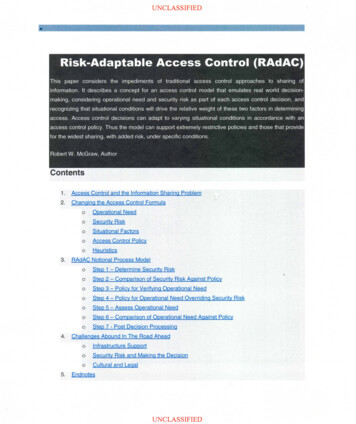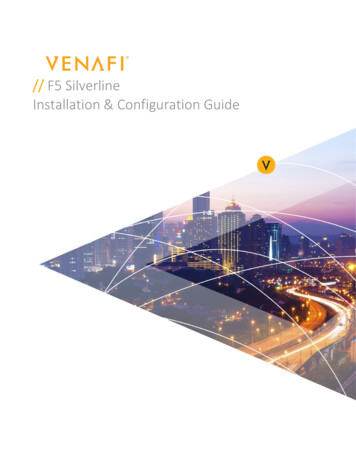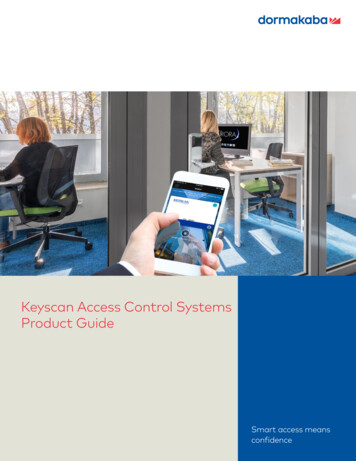
Transcription
Risk-Adaptable Access Control (RAdAC)This paper considersthe impedimentsof traditionalaccess control approachesto sharing ofinformation. It describes a concept for an access control model that emulates real world decisionmaking, considering operational need and security risk as part of each access control decision, andrecognizing that situational conditions will drive the relative weight of these two factors in determiningaccess. Access control decisions can adapt to varying situational conditions in accordance with anaccess control policy. Thus the model can support extremely restrictive policies and those that providefor the widest sharing, with added risk, under specific conditions.1.Access Control and the Information Sharing Problem2.Changing the Access Control Formula3.4.5.oOperational NeedoSecurity RiskoSituational FactorsoAccess Control PolicyoHeuristicsRAdAC Notional Process ModeloStep 1 - Determine Security RiskoStep 2 - Comparison of Security Risk Against PolicyoStep 3 - Policy for Verifying Operational NeedoStep 4 - Policy for Operational Need Overriding Security RiskoStep 5 - Assess Operational NeedoStep 6 - Comparison of Operational Need Against PolicyoStep 7 - Post Decision ProcessingChallenges Abound In The Road AheadoInfrastructure SupportoSecurity Risk and Making the DecisionoCultural and LegalEndnotes
Access Control and the Information SharingProblemMechanisms for controlling access to information that are available in today's systems do not have theflexibility and basis for decision-making needed to support the goals of information sharing. In the realworld, decisions are regularly made by commanders in the field to give access to, and share classifiedinformation under less than ideal security conditions. These decisions are driven by situational factorsand operational needW. They are made with the belief that the operational benefits of sharing theinformation outweigh the potential security risk[g] of sharing it. The focus of such decisions is achievingoperational success at the expense of added security risk, given any number of situational factors. Thebasis for making these decisions is an understanding of the operational need, the resultant securityrisk, the policies and operating procedures governing the situation, and the knowledge of the effects ofsimilar decisions from the past. Note that while it is essential for commanders to have the latitude tomake these decisions in order to execute their missions, it is unlikely they have a comprehensiveunderstanding of the security risk associated with their decisions. The local ramifications may beunderstood but not the enterprise-wide effects.Contrast this highly dynamic, operationally driven, security risk-based decision process with accesscontrol processes prescribed for information systems in Figure 1. Most of these approaches derivefrom the computersecurity activitiesof the 1980s, and strictly fulfill the laws, policies, andimplementing directives for protecting classified information. They require the intended recipient ofclassified information, the subject, to hold a security clearance commensurate with the classification ofthe information object (Mandatory Access Control), and have a "need-to-know" for the information(Discretionary Access Control). The problem with this approach from a sharing perspective is that itassumes that it is too risky to share information if these criteria are not met. It does not recognize thatin some situations, the consequences to national security of not sharing information might be graverthan those of sharing it, even under the worst of security conditions. The risk-averse security policy ofthe enterprise is hard-coded into the access control logic, with no room to support the dynamic andsituational conditions in the real world. Such policies and supporting access control logic assume ahomogenous environment, where all people that could potentially require access to information have aclearance and are located in secure environments, and all the computers and associated networks thatwould process classified information have the pedigree needed to do so. This situation is not reality,particularly in an enterprise as diverse, complex, and situational as is the 000.
Changing the Access Control FormulaA critical part of implementing effective information sharing then is to implement an object-level accesscontrol process that can deal with the realities of the information sharing environment. The proposedaccess control concept to achieve this environment has been named Risk-Adaptable Access Control(RAdAC, pronounced Raid-ack). What distinguishes RAdAC from traditional models is flexibility andadaptability - flexibility to adapt access control decisions to the situation at hand, much as thecommander's decision process described earlier.The basis and formula for access control decisions must change in order to achieve this flexibility andadaptability. Thus, RAdAC decisions are made based on a number of factors as depicted in Figure 2and discussed here:
Sl3rorlt Rl k09lmninalKl!,!F r'lDcw;jlilonandSupporwg lbfl;'lleOpe.laliooal O temnftllllia l'lAa;gf;,Au:h Ofily 11Il@r .lclJonFunQllonAoxcSl'i R«;UllWltThe proposed model allows operational need to enable access, and under specified conditions, tooutweigh security risk in determining access. Operational need was considered in traditional modelsunder the guise of 'need to know', but was used to restrict access rather than to enable it. It canmanifest itself in many ways such as a person's membership in some community of interest ororganization, or their location. A supervisor or other approving authority might have to attest to aperson's need to have specific information. This interaction is shown in the functional model as"Access Authority Interaction." Given its emphasis here, Operational Need must be characterized andparameterized in such a way that the RAdAC process can use it. It must convey some quantifiablemeasure, not a binary indication.RAdAC incorporates a real time, probabilistic determination of security risk into the access controldecision rather than just using a hard comparison of the attributes of the subject and object as intraditional models. Further, the determination of security risk takes into account a number of factors asshown in Figure 3. It shows that people use information technology (IT) components, which connectand use other IT components, and control the information objects that are to be shared. All of theseitems exist in environments that include a physical location and an adversarial threat element. Thetrustworthiness of people, the protection capabilities and robustness of IT components, and the threatlevel of their environments, in conjunction with the value and access history of the information objectbeing accessed, all contribute to the security risk. The process will determine the risk associated witheach of these, as well as a composite risk. Using this risk-based approach enables RAdAC to beresponsive to the broad range of operational situations.
COf'\naeland UseStore Proc ss,eo Control informationTechnol() JYComponentsObject(Resources)The conditions under which the access decision is being made are factored into the process. National,enterprise or local situations may determine these conditions. The national terrorist threat level, or anindication that the enterprise is under cyber attack could tighten or loosen access rules. A situationwhere troops are under severe enemy fire may drive the weighting between operational need andsecurity risk in making an access control decision. It may be critical that those troops be given somepiece of information regardless of the risk that the information might be compromised. Thus, suchconditions may dictate whether operational need can outweigh security risk, regardless of the severityof the security risk.This specifies the rules for access control for various classes of information objects under differentconditions. It allows the enterprise to describe the degree of operational need required to "override"acceptable or normal security risk, and to set acceptable levels of risk. It must be capable of specifyingthe policy for each step of the RAdAC process. The policy might specify the relative weighting ofpersonnel risk, IT component risk, and environmental risk in computing a composite risk. Effectivelyimplementing and managing digital access control policies is a critical element to making the RAdACmodel successful.Knowledge of past access control decisions will be used in making each subsequent decision. Suchknowledge can be used to develop better algorithms for determining risk and operational need, andhelp to fine-tune the access control policy to improve the rate of positive access control decisions.Knowledge of compromises that have resulted under various access conditions, for example, mighthelp the system more accurately determine risk and make better decisions. Policy must specify thedegree to which heuristics should be considered in each access decision, as well as how eachdecision should be incorporated into the learning process.
RAdAC Notional Process ModelA notional representation of the RAdAC process flow is shown in Figure 4. Note that there are otherprocess flows that could accomplish the same or similar results. A request to access an object initiatesthe RAdAC process, which includes these steps:A real-time, probabilistic determination of the security risk associated with granting the requestedaccess is made based on examining several external factors. The level of risk will be determined inseveral different areas such as the risk associated with the people, IT components, and environmentinvolved in the access. The result of this process is some quantitative indication of the level of risk foreach area, as well as a composite risk.In this step, the result of the measured security risk is compared with the access control policy thatidentifies the acceptable level of risk for the object being accessed. The level of risk will be compared
for several different areas such as people, IT components, and a composite risk. The policy will haveto specify an acceptable risk level for each area, or a risk range (e.g. low, normal, and high).At this point the security risk of granting access has been determined to be acceptable, but therequestor might not have an operational need to access the information. The policy will specifywhether verificationof operational need is required for access, and if required, the criteria fordetermining it. If the policy requires operational need to be verified further processing is required,otherwise, access is granted.This step occurs if the security risk was determined to be unacceptable in one or more areas, but therequestor might have an operational need to access the information regardless of that risk. The modeland the policy must be capable of specifying whether operational need may outweigh security risk,specificallyfor whichareasof risk operationalneedmay takeprecedence(e.g.person'strustworthiness, their location, weak IT components, etc.), and under what conditions (e.g. situationalfactors). If override is allowed then further processing is required to determine whether the requestor'soperational need is critical enough to outweigh the security risk, the criteria for which must be specifiedin the policy. If override is not allowed in any area where the risk was not acceptable, then access isdenied.During this step, several factors are examined to determine if the requestor has the operational needrequired to access the object. The policy would specify different requirements for determiningoperational need, depending on whether the security risk was acceptable, or depending on why it wasunacceptable. The requestor's membership in some community of interest or organization, theirlocation, their rank or some other discretionary factor might be used to determine operational need.Another person or an automated service might have to attest to the requestor's operational need toaccess the information and thus, an external workflow process might be engaged to seek suchapproval.The final step is to determine if all of the requirements for operational need, as specified in the policy,were met. If all requirements were met then access is granted. Otherwise it is denied. The policy mustbe capable of identifying the criteria for determining sufficient operational need under both stressedand unstressed security conditions.
The actual decision, the rationale for the decision, and any other pertinent information are analyzedand stored by post RAdAC decision processing. The analysis of the results would be doneautomatically, in real time, and made available to aid and improve the RAdAC decision engine. Resultsof access control decisions would be made available to information owners/authorities to help themassess and adjust access control policies. The degree of information sharing occurring in theenterprise could also be measured and compared with performance metrics.Challenges Abound In The Road AheadRAdACreflects a significantdeparturefrom existingaccess controlmodels and supportingtechnologies. There are numerous challenges that must be solved before it can be fully implementedin the 2016 and beyond timeframe. These challenges are in addition to the increasing demands forhigher assurance in access control implementations. Despite the many challenges there is reason forcautious optimism that the technology needed can be developed in as much as the rudiments alreadyexist, and there is some overlap between the needs and the business opportunities, which havealready been identified. Undoubtedly the final solution will contain elements of many of the presentcapabilities and a variety of other new technologies beyond comprehension today. Here are few of thechallenge areas that will need to be addressed:A supporting infrastructure that will supply various information and services must be in place in orderfor RAdAC to be successful. Actually, this problem is true for any object level access controlmechanism, but RAdAC offers some added challenges. Figure 5 shows RAdAC in context of thesupporting infrastructures that must be available to support it. Some of the infrastructure challengesare:Acce PolicyEnforcementUloef( u,*,ct)ITCompon !f110 )'--ITComponentAcn' DecisionHmOC)'Resour e(Obj1 t)
User Information - This is the source of any informationRAdAC would need to assess thetrustworthiness of the people involved in the access decision, such as identification and authenticationinformation, and authorizations such as their security clearance. Since RAdAC will have to renderaccess decisions for people that do not hold security clearances, other information will need to beavailable to use in the risk determination process to determine a level of risk associated with grantingthem access. What sort of information might be valuable to determining their trustworthiness? Could amini background investigation be done online?IT ComponentInformation - Sufficient knowledge of the information assurance capabilitiesandsecurity robustness of a computing platform, as well as the risk associated with the environment inwhich it resides, will be required to determine the security risk of allowing access from that computingplatform. While this may seem daunting, initiatives by the Trusted Computing Group (TCG) ,anindustry and government consortium, will help to meet this challenge. The TCG is developing ascheme as part of its Trusted Network Connect specification that enables a platform to "prove" itssecurity goodness to another in a secure, verifiable manner. This approach could be used to determinethe configuration of the platform, for which a security risk could then be assigned. It may also bepossible to use informationavailable from security risk assessmentsdone as part of systemcertification and accreditation processes. Under this approach, risk calculations would be availableonline to support RAdAC risk determination. When information is to be sent to a user of a particularsystem, the certification and accreditation risk assessment values for that system could be used in theRAdAC risk calculation.Access Control Policy - A robust infrastructure must exist to provide the access control policiesneeded to support RAdAC based decisions. At a high level, this infrastructure element must provide arepository from which machine-readable access control policies can be served. Far more challengingthough is that it must provide a policy conversion function. This function must be able to capture thepolicymakers' intent for how information should be shared under various situations, and translate it intomachine-readablepolicy statements. The language used for machine-readablepolicies must becapable of expressing the broad range of policy considerations associated with RAdAC. It must beextensible, provide rules for allowable and disallowable policy constructs, and for policy negotiationand deconfliction. The later item will be particularly important since policies could originate from thevarious hierarchies of the government, as well as from other governments whose information might becontrolled by RAdAC. Inconsistencies are likely to abound and deconfliction will be essential. Whilemuch of this capabilityis beyond the limits of technologytoday, there is hope that positiveimprovements can be made in this area given the fact that the rudiments of such a capability alreadyexist.
At the core of RAdAC is the notion of determining risk associated with people, IT components, andtheir environment. Capabilities will need to be developed to produce meaningful and consistent riskcalculations. Bayesian probability methods may hold promise, as well as use of fuzzy set theory formaking decisions under the less than precise conditions that will often exist. Additionally, algorithms orheuristics developed to support decision making must be able to be dynamically tuned to supportadaptive adjustments in information sharing policies. Because of the security criticality of all of thismachinery, proof of correctness will be a critical factor in the implementation of these processes.Further, despite the complexity of its decision process, low latency performance will be critical tomaking RAdAC feasible. The access control decision must, with few exceptions, be instantaneous."Giving uncleared people access to c1qssified information?!!!That's illegal! How could you everconsider doing that? My information is far too sensitive to ever allow that to happen!" Culture will be adifficult barrier to overcome. RAdAC doesn't itself give unfettered access. Rather, its objective is toemploy technology to allow policy makers to drive information sharing to the extent required for thesituation at hand. By changing the basis for the access control decision as described earlier, RAdACcan support extremely restrictive policies and those that provide for the widest sharing, with added risk,under specific conditions. Gaining trust that this model can satisfy this claim will take time, and aneffective transition strategy will be required that allows cultural and legal obstacles to be addressedalong the way.1.[j Operational need as used here means the degree to which success of an operation ormission is dependent on sharing the information.2.[j Notionally, security risk is an indication of the probability that a particular sharing decisionwill result in unintended consequences. Examples of unintended consequences are disclosureof information other than intended by the sharing decision, loss of integrity of the sharedinformation, or loss of integrity of a system.3.[ utinggroup.org/homeTCGseetheirwebsiteat
access control policy. Thus the model can support extremely restrictive policies and those that provide for the widest sharing, with added risk, under specific conditions. 1. Access Control and the Information Sharing Problem 2. Changing the Access Control Formula o Operational Need o Security Risk o Situational Factors o Access Control Policy .










